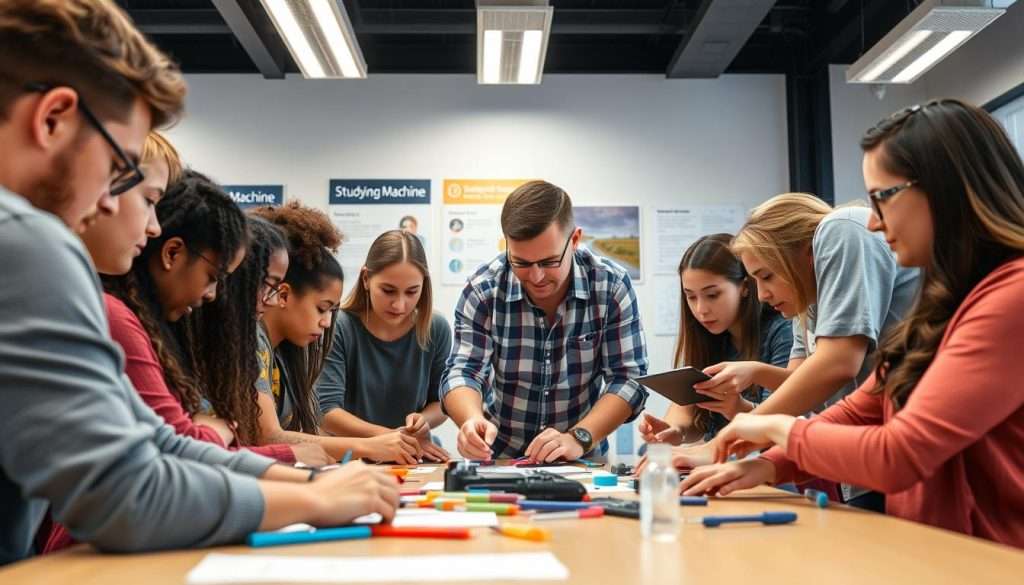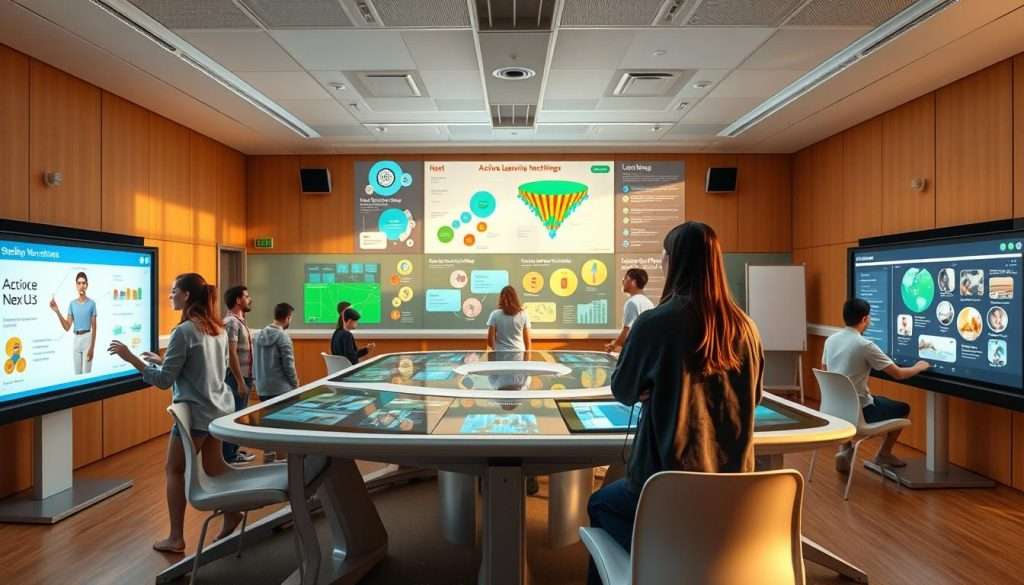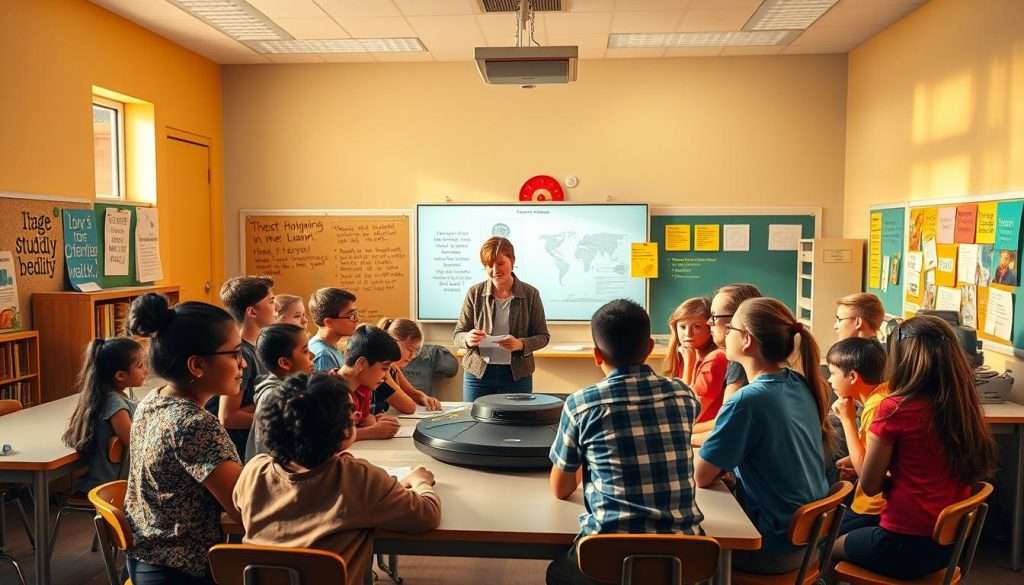Are you tired of studying feeling like a chore? We believe that learning should be an exciting journey, not a tedious task! By shifting from passive to active learning, you can unlock a more engaging and effective educational experience.
Active learning focuses on engaging you in your own learning process. It uses class activities like discussions, debates, and group problem-solving exercises. This approach not only makes studying more enjoyable but also enhances your understanding and retention of the material.
By incorporating active learning techniques into your study routine, you can take your learning to the next level.
Key Takeaways
- Transforming your study approach to active learning can make studying more enjoyable.
- Active learning techniques include discussions, debates, and group problem-solving exercises.
- Engaging in your own learning process enhances understanding and retention.
- Active learning is a more effective educational experience compared to traditional passive learning.
- You can elevate your learning by incorporating active techniques into your study routine.
Understanding the Learning Spectrum: Passive vs. Active Approaches
How we learn affects how well we understand and remember information. It’s important to know the difference between passive and active learning. The choice we make can greatly impact our school success.
Defining Passive Learning and Its Limitations
Passive learning means getting information without really engaging with it. This can be listening to lectures without joining in or reading without breaking it down.
Common Examples of Passive Learning Methods
- Listening to lectures without interaction
- Reading texts without summarizing or analyzing
- Watching educational videos without reflection
The Power and Benefits of Active Learning
Active learning, however, means getting involved with the material. This can be through solving problems, discussing, or testing yourself. It’s proven to help us understand and remember better.
Research-Backed Advantages of Active Engagement
| Benefit | Description | Impact |
|---|---|---|
| Improved Retention | Active recall strengthens memory | Long-term understanding |
| Deeper Understanding | Engagement promotes analysis | Better application of knowledge |
| Enhanced Engagement | Interactive methods increase motivation | Reduced dropout rates |
Why Most Students Default to Passive Methods
Many students stick to passive learning because it’s what they’re used to. But knowing its limits can push them towards more interactive and effective ways of learning.
The Science Behind Effective Learning
Learning how our brains work is key to better learning. When we learn, our brains link neurons, creating a network. This is how we remember things.
How Your Brain Processes Information
Our brains handle information in complex ways. It starts with sensory input. Then, it filters and picks what’s most important for our short-term memory. Hands-on learning approaches make this process more fun and memorable.
Memory Formation and Retention Principles
Creating memories is a big part of learning. First, we store new info in short-term memory. To keep it, we need to move it to long-term memory through practice. Experiential learning helps make this easier.
The Forgetting Curve and How to Combat It
The forgetting curve shows how we forget info over time. To fight this, we use spaced repetition and active recall. These methods help us keep info in our memory better.
The Neurological Benefits of Active Engagement
Being active in learning is very important. It makes our brains release dopamine, which boosts motivation and pleasure. This makes learning more fun and effective. Using hands-on learning approaches and experiential learning makes learning more engaging.
Signs You’re Stuck in Passive Learning Patterns
Are you stuck in a learning rut, just taking in information without really getting it? Many students find themselves stuck in passive learning. This can make it hard to understand and remember new things. We’ll look at common habits and the costs of passive learning.
Common Passive Learning Habits to Recognize
Passive learning shows up in habits like just re-reading notes and not joining in class discussions. To break this cycle, it’s crucial to first recognize these habits. For example, if you’re highlighting a lot of text without getting it or remembering it later, you’re in passive mode.
The Hidden Costs of Passive Learning
Passive learning might seem easy, but it has big costs. We’ll look at two main areas it affects.
Academic Performance Impact
Passive learning can hurt your grades because it doesn’t help you really understand the material. If you’re not actively learning, you won’t remember it for tests.
Long-term Knowledge Retention Issues
Also, passive learning makes it hard to remember things long-term. Without really engaging, you don’t store information in your memory well. This makes it tough to recall later.
| Learning Approach | Short-term Outcome | Long-term Outcome |
|---|---|---|
| Passive Learning | Temporary memorization for exams | Poor retention, difficulty in applying knowledge |
| Active Learning | Deeper understanding, better grades | Long-term retention, ability to apply knowledge |
Self-Assessment: Where Do You Fall on the Learning Spectrum?
To move from passive to active learning, start by checking your learning habits. Ask yourself: Are you just reading notes, or are you really engaging with the material through participatory learning activities? Thinking about how you learn is the first step to a more student-centered learning approach.
From Passive to Active Learning: The Transformation Process
Changing from passive to active learning is more than just a change in how you study. It’s a deep transformation in how you interact with knowledge. This shift is key for learning well and needs a variety of steps.
Mindset Shifts Required for Active Learning
To start active learning, you must change your mindset. First, believe you can learn and that it’s a hands-on process. Be ready for challenges and see failures as chances to learn. Having a growth mindset is key to this change.
Setting Up Your Learning Environment for Success
Your learning space is vital for active learning. It must be both physical and digital.
Physical Space Optimization
Make your study area the best it can be. This means less distraction and more comfort. Think about these:
- Clear your study area to clear your mind.
- Good lighting and comfy seats are a must.
- Choose furniture that supports you during long study times.
Digital Environment Organization
Keeping your digital space organized is just as important. This includes:
- Use digital tools to sort and focus tasks.
- Set up a system to keep notifications away.
- Try apps to make learning easier.
Creating a Personalized Active Learning Plan
Make a plan that fits you by knowing how you learn best. This plan should have:
- Clear goals you can reach.
- Learning methods that work for you.
- A schedule that includes active learning.
Step-by-Step Implementation Timeline
Make a timeline to follow your plan. It should cover:
- First steps to set up your space.
- How you’ll actively engage with your studies.
- Regular checks to see how you’re doing and adjust as needed.
By following these steps and sticking to active learning, you’ll improve your learning a lot.
Core Active Learning Techniques for Different Subjects
Active learning fits different subjects in unique ways. You’ll see how various methods can boost your learning in different areas.
STEM Subjects: Problem-Solving and Application Methods
STEM subjects need hands-on problem-solving and application. The Feynman Technique is great for this. It makes complex ideas simple to understand.
The Feynman Technique for Complex Concepts
The Feynman Technique has four steps. First, pick a concept. Then, explain it like you’re teaching a beginner. Next, find what you didn’t cover well. Finally, make your explanation clearer. This method strengthens your grasp and shows where you need more work.
Humanities: Discussion, Debate, and Critical Analysis
In humanities, active learning means discussing, debating, and analyzing. Socratic Questioning is a key method for deeper understanding.
Socratic Questioning Methods
Socratic Questioning asks questions to spark critical thinking. It helps you dig into complex ideas, spot biases, and build strong arguments.
Languages and Communication: Immersion and Practice Strategies
For languages and communication, active learning means immersing yourself and practicing. Active Vocabulary Building Exercises are crucial for learning a new language.
Active Vocabulary Building Exercises
Building vocabulary actively means using new words, making flashcards, and speaking with native speakers. These activities strengthen your vocabulary and improve your speaking skills.
| Subject Area | Active Learning Techniques | Benefits |
|---|---|---|
| STEM | Problem-solving, Feynman Technique | Improved understanding of complex concepts, enhanced problem-solving skills |
| Humanities | Discussion, Debate, Socratic Questioning | Deeper understanding of texts, improved critical thinking and argumentation skills |
| Languages | Immersion, Active Vocabulary Building | Increased fluency, improved vocabulary retention |
Collaborative and Experiential Learning Approaches
Let’s explore the world of collaborative and experiential learning. Here, you’ll see how teamwork and hands-on learning change education. These methods make learning fun, interactive, and more effective.
Study Group Dynamics That Enhance Learning
Study groups can be very helpful if done right. Working together, you can learn new things, fill in knowledge gaps, and stay motivated. Good study groups have clear goals, active participation, and mutual respect.
Structured vs. Unstructured Collaboration
There’s a debate on whether study groups should be structured or unstructured. Structured groups have clear goals and roles, while unstructured ones are more flexible. Structured groups are great for complex topics, as they keep everyone focused.
Project-Based Learning Implementation
Project-based learning is all about tackling real-world projects to learn new skills. Studies show it boosts critical thinking and problem-solving. It helps you develop practical skills, critical thinking, and creativity.
| Benefits | Project-Based Learning | Traditional Learning |
|---|---|---|
| Engagement | High | Low |
| Skill Development | Practical Skills | Theoretical Knowledge |
| Retention | High | Low |
Real-World Application Opportunities
Experiential learning goes beyond the classroom. Real-world application opportunities like internships and volunteer work offer hands-on experience. They help you apply what you’ve learned to real problems.
Internships and Volunteer Work as Learning Tools
Internships and volunteer work are great for gaining real-world experience. They let you apply your knowledge, learn new skills, and build your network. By taking part in these participatory learning activities, you’ll improve your learning and become more appealing to employers.

Transforming Traditional Study Methods
Let’s change your study routine with new learning strategies. Old methods like highlighting and cramming might not work well. It’s time to try new ways that can make learning better and stick with you longer.
From Highlighting to Concept Mapping
Highlighting text can feel like just going through the motions. Try concept mapping instead. It’s a visual way to link ideas and concepts together. This helps you see how different information is connected.
Digital and Physical Mapping Tools
You can use digital tools like MindMeister or Coggle, or stick to physical methods like sticky notes and whiteboards. See what works best for you. For example, you can make a concept map with MindMeister to organize your study materials in a visual way.
From Re-reading to Retrieval Practice
Re-reading your notes might feel like you’re learning, but retrieval practice is better. It’s about actively recalling information from memory, not just reading it again.
Flashcard Systems and Spaced Repetition
Flashcards or apps like Anki are great for spaced repetition. This method helps you review material at the best times. It makes learning stick longer and deeper.
- Create flashcards with key terms on one side and definitions or explanations on the other.
- Review them regularly, using spaced repetition to maximize retention.
From Cramming to Distributed Practice
Distributed practice means studying over time, not all at once. It helps you remember better and feel less stressed.
“The key to success is not to cram, but to distribute your study sessions effectively.”
By using these new study methods, you can make learning more student-centered and collaborative. This sets you up for success.
Technology Tools That Facilitate Active Learning
Using technology can make learning more fun and effective. The right tools can change how you study, making it more interactive and enjoyable.
Interactive Learning Platforms and Apps
Interactive learning platforms and apps change how we learn. Tools like Kahoot and Quizlet let you create quizzes and games. This makes learning a fun competition.
These platforms add to your study materials, giving you a deeper experience.
Digital Note-Taking and Organization Systems
Digital note-taking systems like Evernote and OneNote help organize your study materials. They let you tag, search, and link your notes. This makes reviewing and referencing easier.
Keeping your notes digital means you can access them anywhere. It also helps reduce clutter.
Virtual Collaboration and Discussion Tools
Tools like Slack and Microsoft Teams make group work easier. They let you connect with peers, share resources, and have meaningful conversations. Online discussions offer different views and help deepen your understanding.

Conclusion: Embracing the Active Learning Mindset for Lifelong Success
Shifting from passive to active learning changes the game for students. It helps you understand and remember course material better. By using student engagement strategies, you can make your brain work harder and learn more effectively.
Active learning is more than just a study method. It’s a way of thinking that can improve many parts of your life. By being more involved and active, you’ll gain skills that help you succeed in many areas, not just school. We urge you to keep trying out and using active learning methods to achieve lasting success.
Now that you know about active learning’s benefits and methods, it’s time to start using them. Try different ways to see what works best for you. This will change how you learn. And it will help you reach your academic goals and love learning for a long time.

